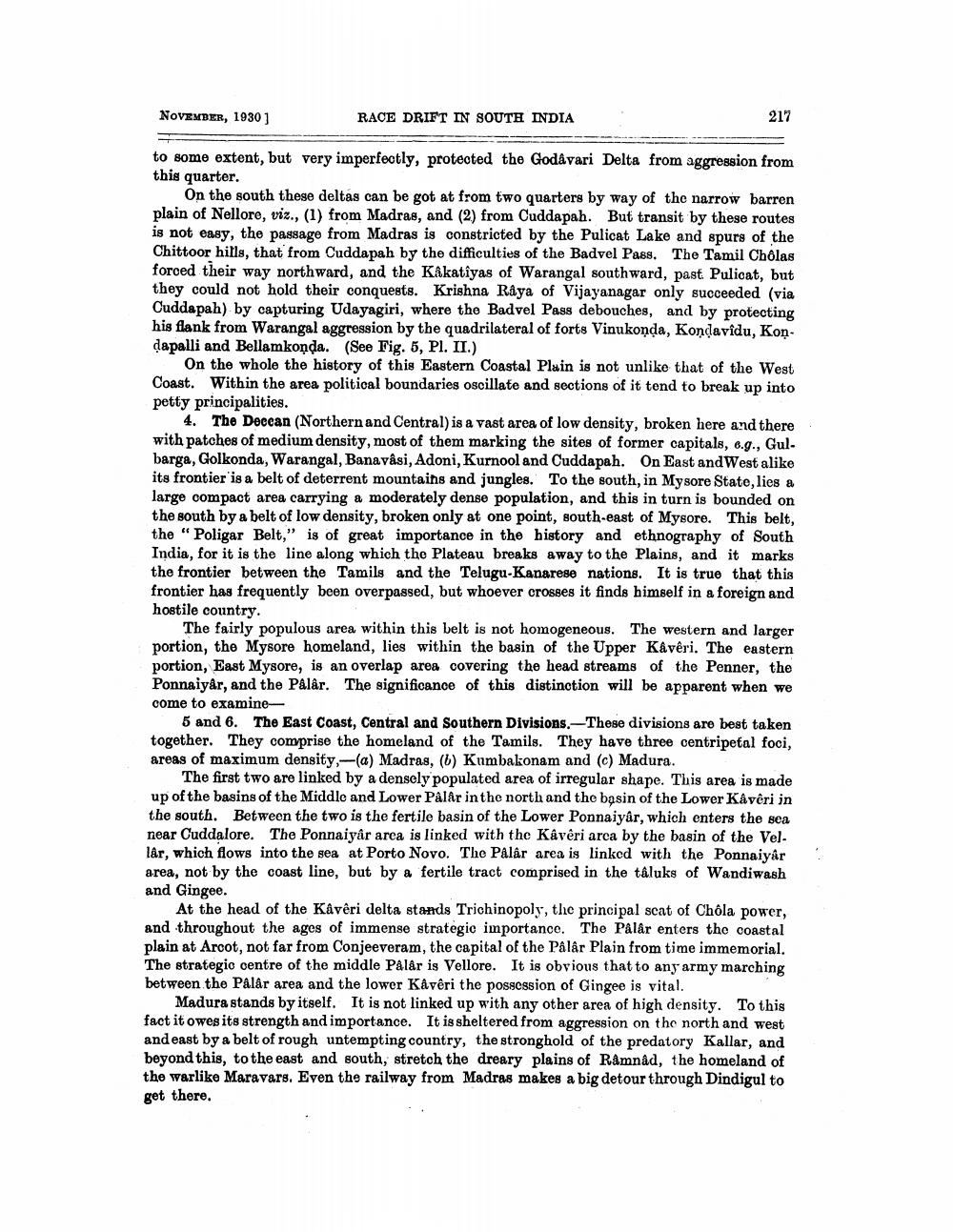________________
NOVEMBER, 1930 ]
RACE DRIFT IN SOUTH INDIA
217
to some extent, but very imperfectly, protected the Godavari Delta from aggression from this quarter.
On the south these deltas can be got at from two quarters by way of the narrow barren plain of Nellore, viz., (1) from Madras, and (2) from Cuddapah. But transit by these routes is not easy, the passage from Madras is constricted by the Pulicat Lake and spurs of the Chittoor hills, that from Cuddapah by the difficulties of the Badvel Pass. The Tamil Cholas forced their way northward, and the Kakatiyas of Warangal southward, past. Pulicat, but they could not hold their conquests. Krishna Raya of Vijayanagar only succeeded (via Cuddapah) by capturing Udayagiri, where the Badvel Pass debouches, and by protecting his flank from Warangal aggression by the quadrilateral of forts Vinukonda, Kondavidu, Kondapalli and Bellamkonda. (See Fig. 5, PI. II.)
On the whole the history of this Eastern Coastal Pluin is not unlike that of the West Coast. Within the area political boundaries oscillate and sections of it tend to break up into petty principalities.
4. The Deccan (Northern and Central) is a vast area of low density, broken here and there with patches of medium density, most of them marking the sites of former capitals, 6.9., Gul. barga, Golkonda, Warangal, Banavâsi, Adoni, Kurnool and Cuddapah. On East and West alike its frontier is a belt of deterrent mountains and jungles. To the south, in Mysore State, lies a large compact area carrying a moderately dense population, and this in turn is bounded on the south by a belt of low density, broken only at one point, south-east of Mysore. This belt, the "Poligar Belt," is of great importance in the history and ethnography of South India, for it is the line along which the Plateau breaks away to the Plains, and it marks the frontier between the Tamils and the Telugu-Kanarese nations. It is true that this frontier has frequently been overpassed, but whoever crosses it finds himself in a foreign and hostile country.
The fairly populous area within this belt is not homogeneous. The western and larger portion, the Mysore homeland, lies within the basin of the Upper Kaveri. The eastern portion, East Mysore, is an overlap area covering the head streams of the Penner, the Ponnaiyâr, and the Palâr. The significance of this distinction will be apparent when we come to examine
5 and 6. The East Coast, Central and Southern Divisions. These divisions are best taken together. They comprise the homeland of the Tamils. They have three centripetal foci, areas of maximum density,-(a) Madras, (6) Kumbakonam and (c) Madura.
The first two are linked by a densely populated area of irregular shape. This area is made up of the basins of the Middle and Lower Palår in the north and the basin of the Lower Kaveri in the south. Between the two is the fertile basin of the Lower Ponnaiyar, which enters the sea near Cuddalore. The Ponnaiyâr area is linked with the Kávéri area by the basin of the Vel. lâr, which flows into the sea at Porto Novo. The Palâr area is linked with the Ponnaiyâr area, not by the coast line, but by a fertile tract comprised in the tâluks of Wandiwash and Gingee.
At the head of the Kâvêri delta stands Trichinopoly, the principal scat of Chộla power, and throughout the ages of immense strategic importance. The Pâlâr enters the coastal plain at Aroot, not far from Conjeeveram, the capital of the Palâr Plain from time immemorial. The strategic centre of the middle Palâr is Vellore. It is obvious that to any army marching between the Palár area and the lower Kåvêri the possession of Gingee is vital.
Madura stands by itself. It is not linked up with any other area of high density. To this fact it owes its strength and importance. It is sheltered from aggression on the north and west and east by a belt of rough untempting country, the stronghold of the predatory Kallar, and beyond this, to the east and south, stretch the dreary plains of Ramnâd, the homeland of the warlike Maravars. Even the railway from Madras makes a big detour through Dindigul to get there.




